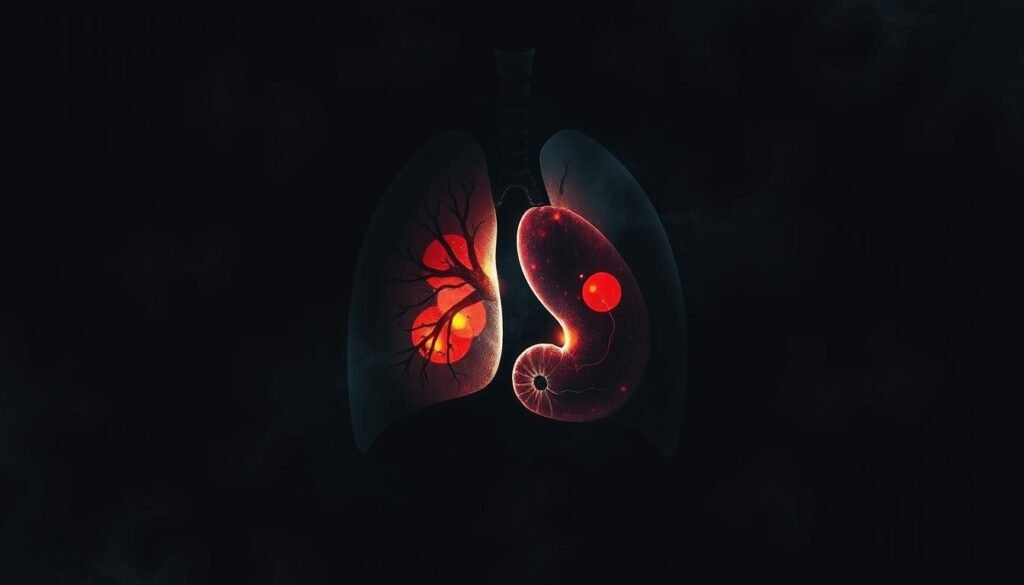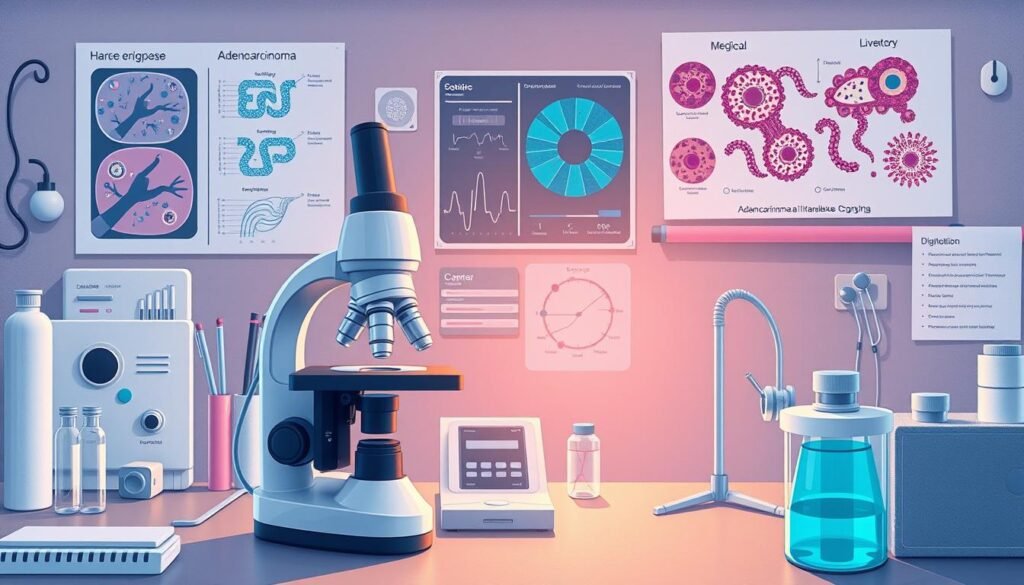Did you know that pancreatic adenocarcinoma has a mere five-year survival rate of just 8.5 percent? This shocking statistic highlights the need to understand this cancer type. It starts from glandular cells in various organs. Adenocarcinoma plays a big role in cancer numbers. It’s behind about 95 percent of colon and rectal cancers and almost all prostate cancers. So, what is adenocarcinoma? Knowing its causes, symptoms, and prognosis is key for those affected.
Adenocarcinoma can spread to many areas like the lungs, prostate, breasts, pancreas, and colon. This makes treatment more complicated and shows why catching it early is so vital. We aim to give a full overview, including its causes, risk factors, symptoms, and treatment choices. For more details on adenocarcinoma, check out Cancer Center and Care Your Lungs.
Key Takeaways
- Adenocarcinoma arises from glandular cells and can affect various organs.
- Approximately 95% of colon and rectal cancers are adenocarcinomas.
- Lung adenocarcinoma accounts for about half of all non-small-cell lung cancer cases.
- Early detection of adenocarcinoma can significantly improve treatment outcomes.
- Personalized treatment plans are essential for managing adenocarcinoma effectively.
- Understanding symptoms related to the cancer’s location can aid in early diagnosis.
What is Adenocarcinoma? Causes, Symptoms, and Prognosis
Adenocarcinoma is a group of cancerous tumors born from gland-like tissue. It can impact different organs across our bodies. The way these cancers are classified depends on where they start. This helps doctors craft specific treatment plans and get a deeper insight into the illness.
Adenocarcinoma Definition
This term includes cancers starting in glands found in places like lungs, prostate, pancreas, and breasts. Each type has its own special traits. These affect how the cancer grows, what treatments work, and what the outlook looks like. Knowing what adenocarcinoma means is key to proper diagnosis and management.
Overview of Adenocarcinoma Types
We know several types of adenocarcinoma, and they all act differently. Here are some examples:
- Lung adenocarcinoma: Makes up 40% of lung cancers. It often develops slowly and appears mainly in the lung’s outer areas.
- Prostate adenocarcinoma: This kind forms in about 99% of prostate cancer cases. Early on, it might not cause symptoms.
- Colorectal adenocarcinoma: It’s the top type of colon cancer and needs routine checks.
- Breast adenocarcinoma: Many breast cancers are of this kind, noted through tissue changes.
- Pancreatic adenocarcinoma: Accounts for 85% of pancreatic cancers. It’s often caught late because early signs are hard to spot.
The wide range of adenocarcinoma types shows why detailed screenings and accurate diagnosis methods are important. By understanding the unique features and symptoms of each type, we can better confront this complicated disease.
Adenocarcinoma Causes
Adenocarcinoma development is linked to many factors. Knowing these adenocarcinoma causes highlights the risks of this cancer. This includes environmental and lifestyle risks, each playing a part in cancer’s development.
Environmental Risk Factors
Certain environmental factors are key in triggering adenocarcinoma. Some common ones are:
- Tobacco smoke, which leads to 80% of lung cancer deaths.
- Air pollution including heavy metals and chemicals.
- Radon gas, a radioactive gas found in homes.
- Exposure to asbestos, especially linked to lung adenocarcinoma.
- Secondhand smoke, which is harmful to non-smokers too.
Those under 45, especially women, are more prone to adenocarcinoma. Having a family history of lung cancer increases the risk by 50%. These facts show the need for awareness and actions like testing homes for radon and avoiding cancer-causing materials. For extra information, check out this resource.
Genetic and Lifestyle Factors
Lifestyle choices also affect cancer risks. These factors include:
- Being overweight and inactive.
- Eating poorly, raising overall cancer risk.
- Genetic mutations like KRAS and EGFR, related to certain cancer types.
- Having chronic conditions like HIV, which increases risk.
Preventive actions, such as stopping smoking and eating well, lower these risks. Knowing your family’s health history helps spot hereditary threats early. Understanding these elements helps grasp adenocarcinoma causes and push for prevention.
Adenocarcinoma Risk Factors
Adenocarcinoma risk factors depend a lot on one’s age, gender, family history, and health status. Knowing about these factors can guide people towards making better health choices. It also encourages seeking early help when needed.
Age and Gender Factors
Most individuals diagnosed with adenocarcinoma are older than 50. Prostate adenocarcinoma is significantly more common in males. Small intestine adenocarcinoma also appears more often in men than women.
This trend continues, with small intestine cancers being more usual in people aged 60 to 70.
Family History and Genetics
Having a family history of cancer increases adenocarcinoma risk. If a close relative has had similar cancers, your risk may go up. Conditions like Lynch syndrome or Familial Adenomatous Polyposis (FAP) also raise the chances of getting adenocarcinoma.
This connection underscores the value of genetic counseling for those with a cancer history in the family.
Other Contributing Conditions
Other risk factors for adenocarcinoma include chronic conditions and personal habits. For example, celiac disease ups the risk for small intestine cancer. Previous colon cancer cases affect risks too. Eating lots of red meat and foods high in salt or smoke can also increase the danger.
Being overweight, having gastroesophageal reflux disease (GERD), or diabetes mellitus links to a higher risk of esophageal adenocarcinoma. Learning about these risk factors from sources like the Mayo Clinic is crucial for preventing the disease and catching it early on.

Adenocarcinoma Symptoms
The symptoms of adenocarcinoma can greatly vary based on where the cancer is located. It’s very important to recognize these symptoms early for the best chance at beating cancer. Knowing the common symptoms will help spot potential problems sooner.
Common Symptoms based on Location
Different kinds of adenocarcinoma bring about specific symptoms:
- Lung Adenocarcinoma: Patients may develop a persistent cough, experience shortness of breath, or notice bloody sputum.
- Prostate Adenocarcinoma: This type can lead to urinary difficulties, such as painful urination or urinary retention, as well as erectile dysfunction.
- Colorectal Adenocarcinoma: Symptoms often include changes in bowel habits, such as diarrhea or constipation, along with abdominal pain or unexplained weight loss.
- Breast Adenocarcinoma: Patients might notice a lump in the breast, changes in breast shape, or unusual discharge from the nipple.
Advanced Symptoms to Watch For
Advanced stages of adenocarcinoma can cause more severe symptoms. These symptoms can be a sign that the cancer is spreading, complicating treatment. For example, in pancreatic adenocarcinoma, intense abdominal pain can become a major issue. Jaundice, or the yellowing of skin and eyes, signifies bile duct problems in the gut. Fatigue and weakness from anemia might indicate internal bleeding. Additionally, nausea and vomiting can occur if tumors interfere with digestion.

Adenocarcinoma Diagnosis
The process of diagnosing adenocarcinoma starts with gathering a detailed medical history and conducting a physical exam. These first steps are crucial for setting the stage for more tests. Early detection is key to finding better treatment options.
Medical History and Physical Examination
Healthcare professionals will ask about any symptoms, cancer in the family, and environment factors that could be important. Then, they check for signs of adenocarcinoma, like lumps or swelling. This information is important for deciding what tests are needed next.
Diagnostic Testing and Imaging
After the initial check, doctors use various tests for a confirmed adenocarcinoma diagnosis. CT scans and MRIs help see inside the body and find where the tumor is. Blood tests might also be done to look for markers of adenocarcinoma.
Sometimes, a biopsy is needed to take a closer look at the tissue. It helps identify the type of cancer, how advanced it is, and any genetic changes that could affect treatment options. For example, lung adenocarcinoma often has changes in the EGFR and KRAS genes. Diagnosing adenocarcinoma this way helps to create a treatment plan that’s right for each patient.

| Diagnostic Method | Description | Purpose |
|---|---|---|
| Medical History | Assessment of personal and family cancer history | Identify risk factors and symptoms |
| Physical Examination | Examination for lumps or unusual signs | Initial indicator of adenocarcinoma |
| Imaging Studies | CT scans, MRIs | Visualize tumors and assess spread |
| Blood Tests | Check for tumor markers | Support diagnosis and monitor progress |
| Biopsy | Tissue sample extraction | Confirm cancer type and grade |
Adenocarcinoma Treatment
Treatment for adenocarcinoma includes many strategies based on the cancer stage and type. It involves surgery, chemotherapy, and radiation. A team of specialists works together to meet the needs of each patient.
Surgical Options and Procedures
Surgery is often the first step to treat adenocarcinoma if the tumor can be removed. The goal is to take out the tumor and some healthy tissue around it. This helps make sure all the cancer is gone. For lung cancer, surgeries like lobectomy or wedge resection are options.
Chemotherapy and Radiation Therapy
Chemotherapy might be used before or after surgery to deal with cancer cells. It’s vital for stopping cancer from coming back. Radiation can help by shrinking tumors or easing symptoms. Using both treatments together can work better against the cancer.
Keeping up with new treatments is important. Things like immunotherapy are showing promise. They might help people live longer with fewer side effects. For more info, see this resource.
| Type of Treatment | Description | Indications |
|---|---|---|
| Surgery | Removal of the tumor and surrounding tissue. | Localized or operable adenocarcinoma. |
| Chemotherapy | Use of drugs to kill cancer cells. | Adjuvant therapy post-surgery or preoperative treatment. |
| Radiation Therapy | Targeted treatment to reduce tumor size or symptoms. | Localized tumors or palliative care. |
Adenocarcinoma Prognosis
The outlook for adenocarcinoma varies greatly. It depends on cancer stage, patient health, and treatment response. Knowing these factors helps predict outcomes and guide care.
Factors Affecting Prognosis
Several important factors influence the outlook of adenocarcinoma:
- Cancer Stage: The cancer’s stage at diagnosis is key. Early stages usually mean better outcomes. But, metastatic cancer suggests a more complex situation.
- Tumor Characteristics: The size of the tumor, lymph node involvement, and metastasis are crucial. They significantly affect survival rates.
- Patient Health: Overall health, including past conditions and lifestyle, impacts survival and healing. For example, smoking has a significant effect.
Understanding Survival Rates
Survival rates for adenocarcinoma can be quite different, reflecting the impact of various factors. Early detection is crucial:
| Cancer Type | 5-Year Survival Rate |
|---|---|
| Lung Adenocarcinoma | Less than 12% to 15% |
| Prostate Adenocarcinoma | Nearly 98% |
| Colorectal Adenocarcinoma | Approx. 64% |
| Breast Adenocarcinoma | About 90% |
About 90% of cancer deaths are linked to metastases. This fact stresses the need for awareness and early action in managing adenocarcinoma. The variety in survival rates shows why it’s important to understand each cancer type’s challenges and indicators.
Types of Adenocarcinoma
Adenocarcinomas come in various forms, making their identification key for treatment. Lung adenocarcinoma stands out, forming 40 percent of lung cancers. It grows in lung gland cells, often signaling its presence with coughing and chest pain. Spotting it early through tests can really help patients. Learn more at this source.
Lung Adenocarcinoma
Prostate adenocarcinoma makes up almost all prostate cancers. It mainly hits older men, causing issues like frequent urination and trouble with erections. Detection tools include PSA tests and special ultrasounds, highlighting the value of regular doctor visits for at-risk individuals.
Colorectal Adenocarcinoma
About 95 percent of cancers in the colon and rectum are Colorectal adenocarcinomas. Warning signs can be abdominal pain and bloody stools. Early detection means, like colonoscopies, are key. Lifestyle changes might also lower risks with this cancer type.
Breast Adenocarcinoma
The bulk of breast cancers are breast adenocarcinomas, mainly invasive ductal carcinoma. Look out for lumps and changes in how your breast looks or feels. Understanding your own and your family’s health history helps with early detection and improving outcomes.